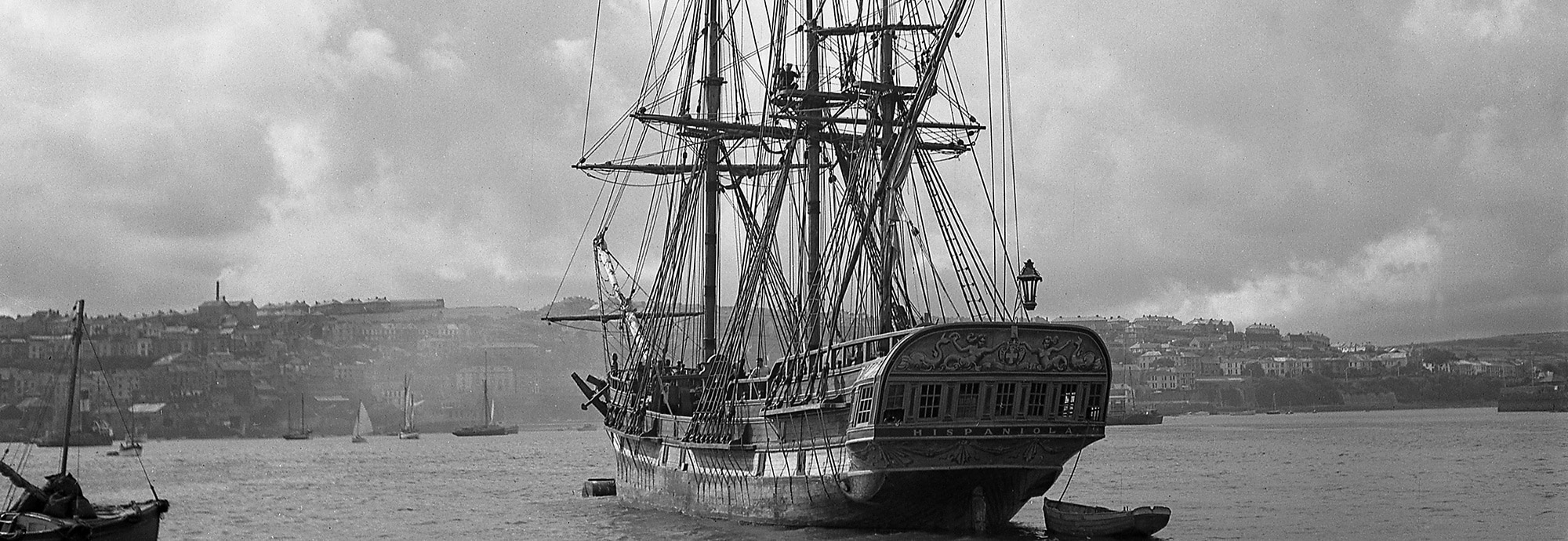

By Linda Batchelor
The new major exhibition Pirates at National Maritime Museum Cornwall has inspired this month’s Bartlett Blog. Were pirates dashing, daring and adventurous or bloodthirsty, immoral and greedy? The exhibition explores how popular culture has shaped how we think of pirates today and one of those influencing factors was the depiction of the pirate world in the novel and film of Robert Louis Stevenson’s Treasure Island.
In the hunt for pirate treasure characters in the book set sail in the schooner Hispaniola and their subsequent adventures have influenced some views of the world of pirates. This Blog considers how the real schooner Ryelands, a hard working coastal trader, was transformed for the filming of the story into the more glamourous fictional schooner Hispaniola and her later story. Much of the filming took place in Cornwall and in the 1950s pirates were often seen in the Carrick Roads, the River Fal Estuary and Falmouth!
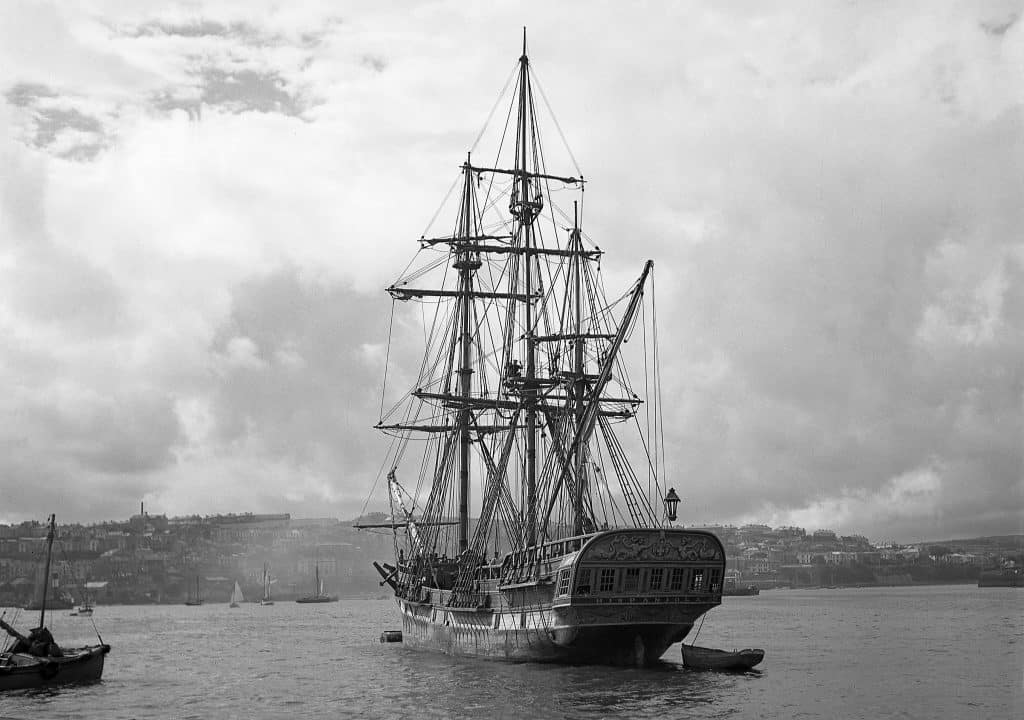
The replica schooner Hispaniola in Falmouth Harbour in 1950. The David Weller Collection © NMMC
The island of Hispaniola is the second largest island in the Caribbean and part of the Great Antilles. The island is now divided into two separate nations of Haiti and the Dominican Republic. The first European to sight the island was Christopher Columbus during his New World expedition of 1492 who renamed it as Espanola, which later became Hispaniola. At the time the island was populated by the Taino people but Columbus claimed it as part of the Spanish empire and it became one of the earliest European settlements in the Americas.
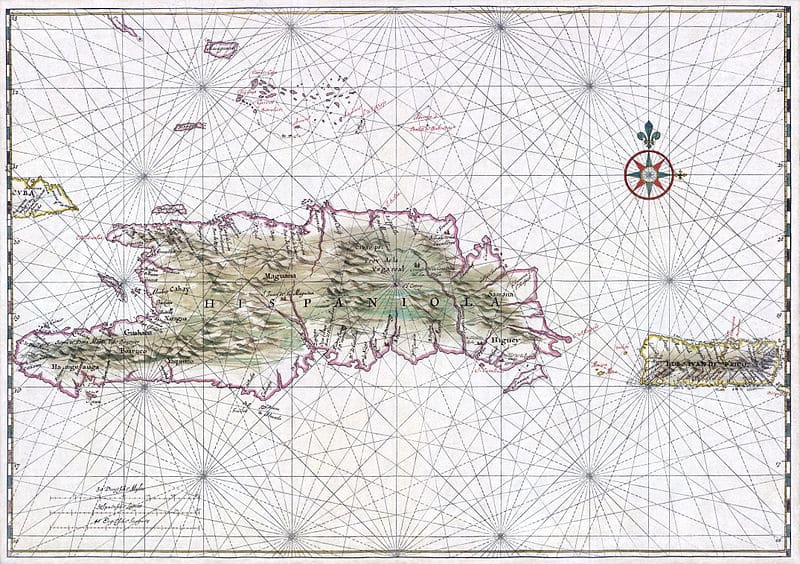
Chart of Hispaniola by J Vinckeboons 1639. Library of Congress.
Spain was a dominant force in colonizing South America and the Caribbean, and much of the wealth discovered there was sent back in convoys of galleons to Spain. As competition grew between European states to develop their overseas settlements and empires grew, so too did the rivalry between them which often led to legalised conflict at sea in the form of privateering. Governments would issue letters of marque to privately owned ships, warrants which legalised the capture and seizure of ships and cargoes from rival states without the threat of prosecution. In an era of vast social division, difficult living for the majority and harsh conditions at sea the promise of adventure and possible wealth made it a short step for many captains and crews from privateering to piracy.
Piracy has a long history from the ocean raiders of the Aegean and Mediterranean in classical times to the hijacking of ships in the present. At various times throughout history many places in the world have been associated with piracy such as Madagascar, Malta and the Barbary Coast and throughout the Caribbean islands where it flourished especially during the Golden Age of Piracy, the period from 1650 to 1730.
Parts of Hispaniola and the neighbouring island of Tortuga were colonised during this period by the French and saw the emergence of pirates or buccaneers known as the Brethren of the Coast who were sometimes paid to attack Spanish ships. The position of the islands on the sea routes to Europe made it easy for pirates to stage attacks on ships returning to Europe, particularly the Spanish treasure galleons. The numerous islands afforded plenty of cover for pirate ships and the growing number of colonial settlements provided not only the opportunities for raiding but also a marketplace for supplies and captured loot.
It is not surprising therefore, that when Robert Louis Stevenson came to write the book Treasure Island about the hunt for pirate treasure, he should name the ship in the story Hispaniola. The ship is described by Squire Trelawney, a major character in the book, who purchases the ship in Bristol, as ‘You never imagined a sweeter schooner – a child might sail her – two hundred tons; name Hispaniola’.
Treasure Island was first published as a novel in 1883 after serialisation with the title of The Sea Cook in the children’s magazine Young Folks. It is an adventure story narrated by young Jim Hawkins, the son of an innkeeper near Bristol, who discovers a map of an island where pirate treasure is buried. After telling the local doctor and the Squire of his discovery they decide on an expedition to the island to find the treasure, purchase the Hispaniola and set sail on the adventure.
Robert Louis Stevenson was a Scottish novelist, poet and travel writer, the grandson of Robert Stevenson, the famous civil engineer and lighthouse designer. He had an interest in pirates and buccaneers since he was young and the book grew from a story he had first developed for his stepson. He drew on various sources for his story including real characters he had encountered on his travels and from the book A General History of the Pyrates, published in 1724 by Captain Charles Johnson, probably a nom de plume for one of the well-known writers of the time. This book described many real pirates, such as Edward Teach or Blackbeard, their activities and the use of such terms as ‘Jolly Roger’ and alerted the interest of the public to the pirate world.
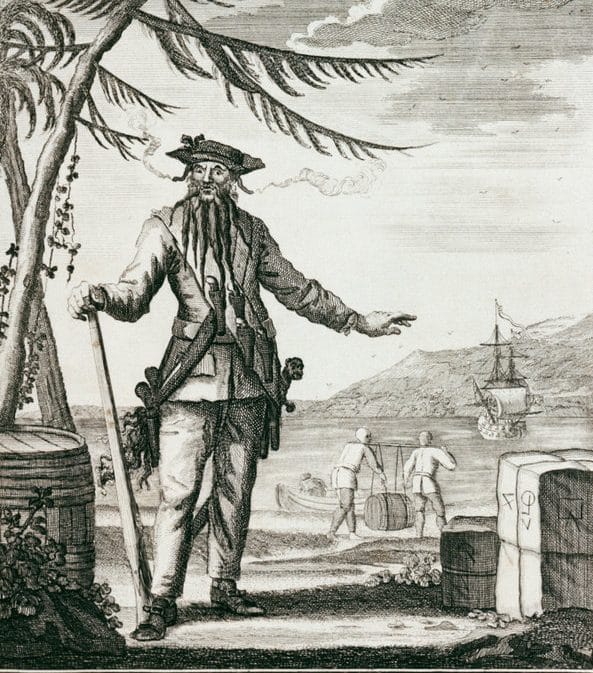
Edward Teach, the Pirate Blackbeard. ‘A General History of the Pyrates’ by Captain Charles Johnson.
Stevenson incorporated such sources in the writing of Treasure Island. Elements of the story and subsequent film and television adaptions have been a major influence in the depiction of pirates in popular culture. Characters such as Long John Silver, Ben Gunn and Captain Flint are now well known and the adventure involves the search for the island, buried treasure, mutinous pirates, ghosts and marooned castaways.
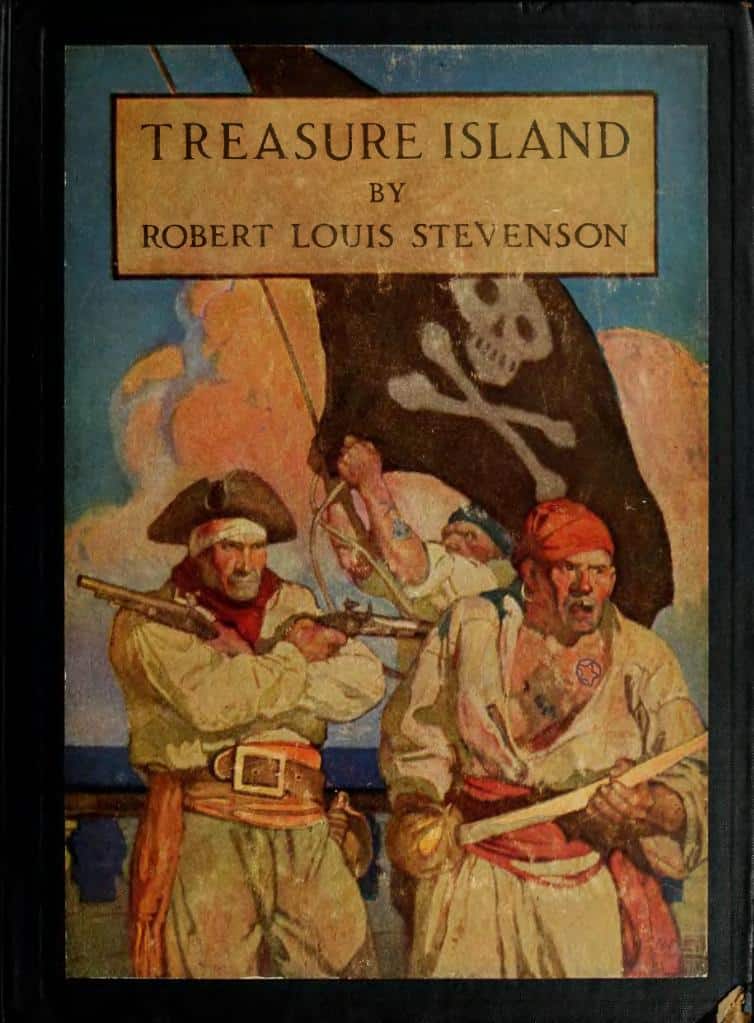
Cover of a 1934 edition of Treasure Island.
A major film adaption of the story was released in 1950 produced by RKO-Walt Disney Productions and filmed on location and in studios in the United Kingdom. It was the first live action film made by Disney and the first made in colour and required real action shots of the Hispaniola at sea. The schooner Ryelands was bought by RKO in 1948 to replicate the Hispaniola for the purpose of filming.
Ryelands was built in 1887 by Nicholson & March of Glasson Dock, Lancaster as a schooner for use in the coastal trade around Britain. Schooners were moderately sized vessels, usually around two hundred tons, with good sailing qualities. Ryelands was a three-masted vessel rigged fore and aft, named after an area in Lancaster, and built for her first Captain, William Marrow of Connah’s Quay in Wales. William was an experienced seaman who had begun his career at sea when he was 11 in 1854. During the build the schooner was almost destroyed by fire but fortunately was saved and began working life carrying a variety of cargoes around Britain.
The ship remained working in the coastal trade for many years including ports in the West Country and frequently shipping China clay from Charlestown in Cornwall. In 1929 Ryelands was acquired by Robert Gardner, a businessman with a small fleet of cargo ships, who had the sailing schooner fitted with an auxiliary engine. By the Second World War wooden ships were becoming outdated but Ryelands was purchased in 1942 by Captain Hugh Shaw for his son Kenneth to work in and around the Bristol Channel. The end of her working life came eight years later when Ryelands was bought by RKO, her name was changed to Hispaniola and the ship began her film career.
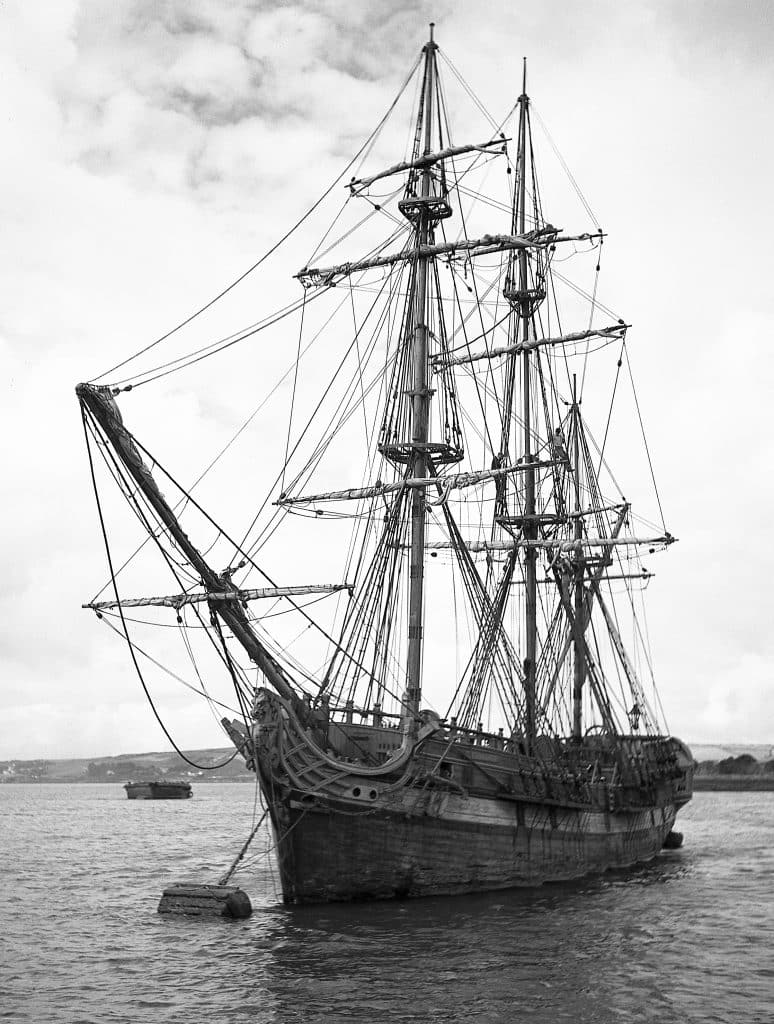
Hispaniola at anchor off Falmouth. The David Weller Collection © NMMC.
The schooner was purchased for the filming of the Disney adventure Treasure Island. The reconfigured Ryelands became the Hispaniola and had a starring role in the film. Studio filming was done at Denham studios in Buckinghamshire whilst other filming took place at various locations including Dorset and Cornwall. Hispaniola was used for all the exterior ship scenes which were filmed in and around the Fal and Helford estuaries and the Carrick Roads and the ship was a frequent visitor to Falmouth during the filming.
When filming was over in 1952 the Hispaniola was purchased by Scarborough Corporation for use as a floating aquarium and tourist attraction moored alongside Centre Pier. She remained there for two years until sold back to the film industry for Elstree Studio’s film ‘Moby Dick’, this time to star as the whaling schooner Pequod and then as the pirate ship Sultana in the TV series ‘The Buccaneers’.
After these starring roles in 1960 the ship was bought by the Morecombe businessman Peter Latham. Peter and his wife Barbara were restoring and developing Glasson Dock and Ryelands was returned to the place of her construction in need of overhaul and repair. Rejuvenated, repainted and named as Moby Dick, the ship was moved to Morecombe as a popular tourist attraction.
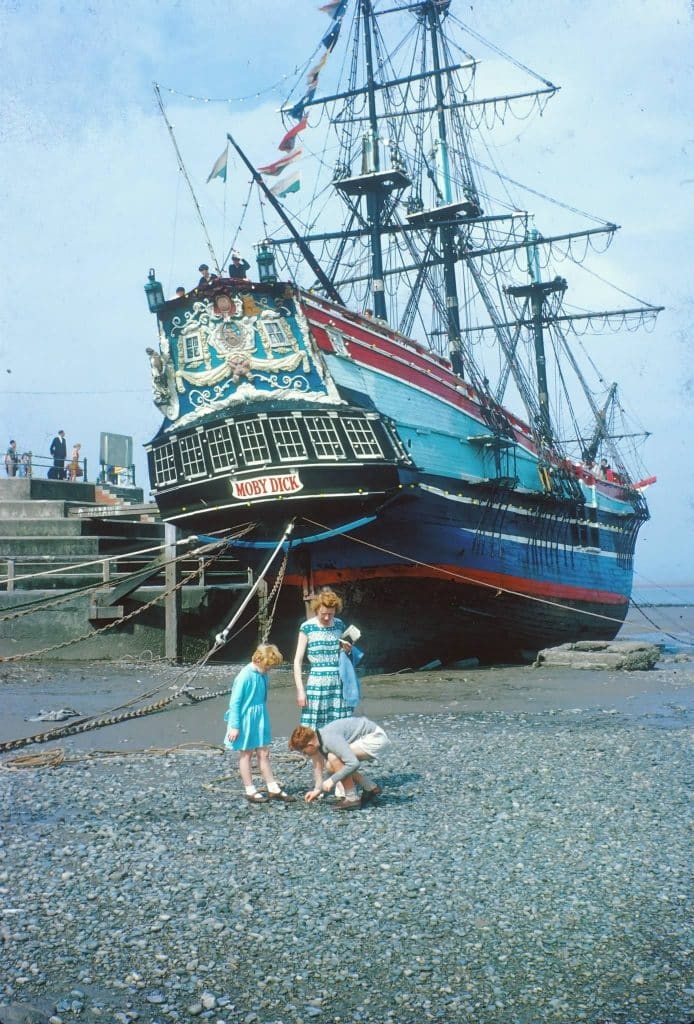
Ryelands as the tourist attraction Moby Dick moored in Morecombe. Lancaster Maritime Museum.
The ship was the last built at Glasson Dock to survive. After construction and launch and named as Ryelands, in 1887 the ship had taken on the life of a purposeful, hardworking coastal trader until in the 1950s she had outgrown her usefulness. It was at that point that Ryelands was transformed into the Hispaniola and became part of the glamourous world of film. She ended her life destroyed by fire in 1972. In both parts of that career the ship mirrored the reality and perception of life at sea for pirates. The reality of the hard work and everyday danger involved in the life of any seafarer and the perception of perhaps the more glamourous adventurous, daring life of pirates.
The Bartlett Blog is written and produced by the volunteers who staff The Bartlett Maritime Research Centre and Library of National Maritime Museum Cornwall. The Hispaniola was written by Linda Batchelor.
The Bartlett Library holds a Collection of over 20,000 volumes and offers access to one of the finest collections of maritime reference books, periodicals and archival material. The Bartlett Blog reflects the diversity of material available in The Bartlett Library.

National Maritime
Museum Cornwall Trust
Discovery Quay
Falmouth Cornwall
TR11 3QY
View Map
See our opening hours
Tel: +44(0)1326 313388
Email: enquiries@nmmc.co.uk